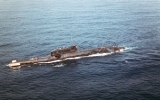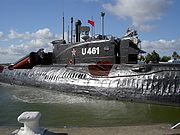
Juliett class submarine
Encyclopedia
The Project 651, known in the West by its NATO reporting name
Juliett class, was a class of Soviet diesel
-electric submarine
s armed with cruise missiles. They were designed in the late 1950s to provide the Soviet Navy
with a nuclear strike capability against targets along the east coast of the United States
and enemy combatants (aircraft carriers). The head of the design team was Abram Samuilovich Kassatsier. They carried four nuclear-capable cruise missile
s with a range of ~300 miles, which could be launched while the submarine was surfaced and moving less than four knots (7 km/h). Once surfaced, the first missile could be launched in about five minutes; subsequent missiles would follow within about ten seconds each. Initially, the missiles were the inertially-guided P-5 (NATO reporting name
SS-N-3
Shaddock). When submarine-launched ballistic missile
s rendered the P-5s obsolescent, they were replaced with the P-6 (also NATO reporting name
SS-N-3
Shaddock, though a very different missile) designed to attack aircraft carriers. A special 10 m2 target guidance radar was built into the forward edge of the sail structure, which opened by rotating. One boat was eventually fitted with the Kasatka
satellite downlink for targeting information to support P-500 4K-80 "Bazalt" (SS-N-12
Sandbox) anti-ship cruise missiles.
The Juliett class had a low magnetic signature austenitic
steel double hull, covered by two inch (50 mm) thick black tiles made of sound-absorbing hard rubber. They had exceptionally high reserve buoyancy, and were divided into eight watertight compartments:

 Initial plans called for 35 submarines of this class. In fact only 16 were actually built, two - including the lead sub by the Baltic Shipyard, St. Petersburg
Initial plans called for 35 submarines of this class. In fact only 16 were actually built, two - including the lead sub by the Baltic Shipyard, St. Petersburg
and the rest by the Krasnoye Sormovo Shipyard in Nizhniy Novgorod. They were commissioned between 1963 and 1968, and served through the 1980s. The last one was decommissioned in 1994.
The Juliett was built due to expected delays in the continued production of the nuclear-powered Project 629 Echo I class submarines
and 675 Echo II class submarines
, with six and eight missile launchers, respectively. The Juliette was actually designed after the Echos.
NATO reporting name
NATO reporting names are classified code names for military equipment of the Eastern Bloc...
Juliett class, was a class of Soviet diesel
Diesel engine
A diesel engine is an internal combustion engine that uses the heat of compression to initiate ignition to burn the fuel, which is injected into the combustion chamber...
-electric submarine
Submarine
A submarine is a watercraft capable of independent operation below the surface of the water. It differs from a submersible, which has more limited underwater capability...
s armed with cruise missiles. They were designed in the late 1950s to provide the Soviet Navy
Soviet Navy
The Soviet Navy was the naval arm of the Soviet Armed Forces. Often referred to as the Red Fleet, the Soviet Navy would have played an instrumental role in a Warsaw Pact war with NATO, where it would have attempted to prevent naval convoys from bringing reinforcements across the Atlantic Ocean...
with a nuclear strike capability against targets along the east coast of the United States
United States
The United States of America is a federal constitutional republic comprising fifty states and a federal district...
and enemy combatants (aircraft carriers). The head of the design team was Abram Samuilovich Kassatsier. They carried four nuclear-capable cruise missile
Cruise missile
A cruise missile is a guided missile that carries an explosive payload and is propelled, usually by a jet engine, towards a land-based or sea-based target. Cruise missiles are designed to deliver a large warhead over long distances with high accuracy...
s with a range of ~300 miles, which could be launched while the submarine was surfaced and moving less than four knots (7 km/h). Once surfaced, the first missile could be launched in about five minutes; subsequent missiles would follow within about ten seconds each. Initially, the missiles were the inertially-guided P-5 (NATO reporting name
NATO reporting name
NATO reporting names are classified code names for military equipment of the Eastern Bloc...
SS-N-3
SS-N-3
The P-5 "Pyatyorka" was a Cold War era turbojet-powered cruise missile of the Soviet Union, designed by the Chelomey design bureau. The missile entered service in 1959...
Shaddock). When submarine-launched ballistic missile
Submarine-launched ballistic missile
A submarine-launched ballistic missile is a ballistic missile capable of delivering a nuclear warhead that can be launched from submarines. Modern variants usually deliver multiple independently targetable reentry vehicles each of which carries a warhead and allows a single launched missile to...
s rendered the P-5s obsolescent, they were replaced with the P-6 (also NATO reporting name
NATO reporting name
NATO reporting names are classified code names for military equipment of the Eastern Bloc...
SS-N-3
SS-N-3
The P-5 "Pyatyorka" was a Cold War era turbojet-powered cruise missile of the Soviet Union, designed by the Chelomey design bureau. The missile entered service in 1959...
Shaddock, though a very different missile) designed to attack aircraft carriers. A special 10 m2 target guidance radar was built into the forward edge of the sail structure, which opened by rotating. One boat was eventually fitted with the Kasatka
Kasatka
Kasatka is a female Orca who lives at SeaWorld San Diego and the mother of Takara, Nakai, and Kalia. She was captured off the coast of Iceland on October 26, 1978, at the age of one year. Her name probably comes from the Russian word Kasatka , a generic name for Orcas...
satellite downlink for targeting information to support P-500 4K-80 "Bazalt" (SS-N-12
SS-N-12
The P-500 Bazalt is a liquid-fueled, rocket-powered, supersonic cruise missile used by the Soviet and Russian navies. Developed by OKB-52 MAP , its GRAU designation is 4K80. Its NATO reporting name is SS-N-12 Sandbox. It entered service in 1973 to replace the SS-N-3 Shaddock...
Sandbox) anti-ship cruise missiles.
The Juliett class had a low magnetic signature austenitic
Austenite
Austenite, also known as gamma phase iron, is a metallic non-magnetic allotrope of iron or a solid solution of iron, with an alloying element. In plain-carbon steel, austenite exists above the critical eutectoid temperature of ; other alloys of steel have different eutectoid temperatures...
steel double hull, covered by two inch (50 mm) thick black tiles made of sound-absorbing hard rubber. They had exceptionally high reserve buoyancy, and were divided into eight watertight compartments:

- the forward torpedo room
- living accommodations for officers and chiefs and the forward batteries
- the missile control room and batteries
- the control room
- crew berthing and batteries
- the forward engine room containing the diesels and generators
- the aft engine room with the electric motors
- the aft torpedo room.

Leningrad
Leningrad is the former name of Saint Petersburg, Russia.Leningrad may also refer to:- Places :* Leningrad Oblast, a federal subject of Russia, around Saint Petersburg* Leningrad, Tajikistan, capital of Muminobod district in Khatlon Province...
and the rest by the Krasnoye Sormovo Shipyard in Nizhniy Novgorod. They were commissioned between 1963 and 1968, and served through the 1980s. The last one was decommissioned in 1994.
The Juliett was built due to expected delays in the continued production of the nuclear-powered Project 629 Echo I class submarines
Echo class submarine
The Echo class submarines were nuclear cruise missile submarines of the Soviet Navy built during the 1960s. Their Soviet designation was Project 659 class for the first five vessels, and Project 675 for the following twenty-nine...
and 675 Echo II class submarines
Echo class submarine
The Echo class submarines were nuclear cruise missile submarines of the Soviet Navy built during the 1960s. Their Soviet designation was Project 659 class for the first five vessels, and Project 675 for the following twenty-nine...
, with six and eight missile launchers, respectively. The Juliette was actually designed after the Echos.
Units
| # | Shipyard | Laid down | Launched | Commissioned | Status |
|---|---|---|---|---|---|
| K-156 | St. Petersburg | November 16, 1960 | July 31, 1962 | December 10, 1963 | Decommissioned September 1991 for scrapping< |
| K-85 | St. Petersburg | October 25, 1961 | January 31, 1964 | December 30, 1964 | Decommissioned for scrapping |
| K-70 | Nizhniy Novgorod | August 25, 1962 | February 6, 1964 | December 31, 1964 | Decommissioned in 1994 for scrapping |
| K-24 | Nizhniy Novgorod | October 15, 1961 | December 15, 1962 | October 31, 1965 | Decommissioned in 1994, sold to Germany as maritime museum exhibit |
| K-68 | Nizhniy Novgorod | January 25, 1962 | April 30, 1963 | December 28, 1965 | Decommissioned in 1990 for scrapping |
| K-77 Soviet submarine K-77 K-77 was a "Project 651" cruise missile submarine of the Soviet Navy. Her keel was laid down in the Krasnoye Sormovo shipyard in Gorky on 31 January 1963... |
Nizhniy Novgorod | January 31, 1963 | March 11, 1965 | October 31, 1965 | Decommissioned in April 1992 and sold as museum exhibit in U.S. |
| K-81 | Nizhniy Novgorod | November 20, 1963 | August 7, 1964 | December 14, 1965 | Decommissioned in 1994 for scrapping |
| K-63 | Nizhniy Novgorod | March 25, 1962 | July 26, 1963 | June 12, 1966 | Decommissioned in September 1991 for scrapping |
| K-58 | Nizhniy Novgorod | July 15, 1963 | February 2, 1966 | September 23, 1966 | Decommissioned 1990 for scrapping |
| K-73 | Nizhniy Novgorod | August 1, 1964 | May 31, 1966 | December 15, 1966 | Decommissioned in 1990 for scrapping |
| K-67 | Nizhniy Novgorod | January 31, 1965 | October 29, 1966 | September 30, 1967 | Decommissioned in 1994 for scrapping |
| K-78 | Nizhniy Novgorod | July 25, 1965 | March 30, 1967 | November 1, 1967 | Decommissioned in September 1991 for scrapping |
| K-203 | Nizhniy Novgorod | December 23, 1965 | June 30, 1967 | December 2, 1967 | Decommissioned in September 1992 for scrapping |
| K-304 | Nizhniy Novgorod | August 6, 1966 | November 24, 1967 | August 21, 1968 | Decommissioned in September 1991 for scrapping |
| K-318 | Nizhniy Novgorod | March 29, 1967 | March 29, 1968 | September 29, 1968 | Decommissioned in 1994 for scrapping |
| K-120 | Nizhniy Novgorod | March 25, 1967 | July 11, 1968 | December 26, 1968 | Decommissioned in April 1991 for scrapping |

